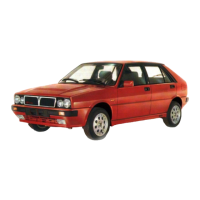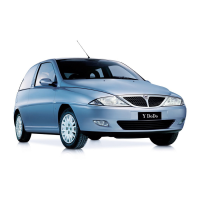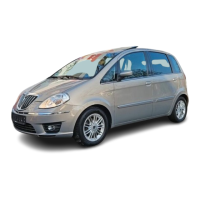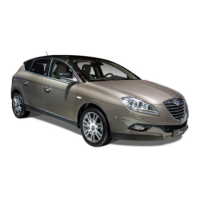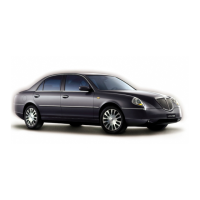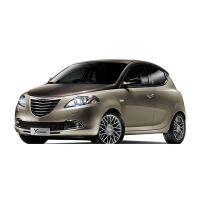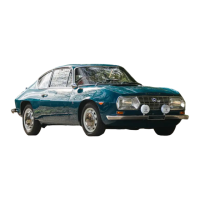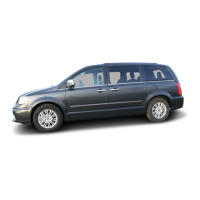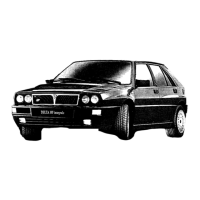Do you have a question about the Lancia Lybra and is the answer not in the manual?
Instructions on how to refuel petrol and diesel engines with the correct fuel types and octane ratings.
Procedure for starting the petrol and diesel engines, including handbrake and gear lever positions.
Warning about parking the car over flammable materials due to catalytic converter high temperatures.
Information on the car's emission monitoring system and environmental protection features.
Highlights instructions critical for driver, passenger, and public safety. Failure to comply can cause serious danger.
Indicates correct procedures to ensure the car does not harm the environment.
Warns about instructions that, if ignored, can lead to serious damage or invalidate the warranty.
Symbols indicating potential dangers related to car components like battery, coil, fan, and expansion tank.
Symbols indicating actions that are forbidden, such as keeping away from flames or children.
Symbols highlighting important precautions for components like the catalytic converter and power steering.
Detailed identification of all instruments and controls on the car's dashboard, including vents and switches.
Explanation of the ignition switch positions (STOP, MAR, AVV, PARK) and steering column lock engagement.
Information on the engine immobilising system, keys, and the CODE card for emergency starting.
Description of the electronic alarm system's components, operation, and protection features.
Instructions for adjusting manually and electrically operated seats, including lumbar support and heating.
Guidance on how to fasten, release, and adjust seat belts for optimal safety.
Guidelines and safety recommendations for carrying children safely in the car using restraint systems.
Explanation of the front and side airbag systems, their operation, and important safety precautions.
Identification of gauges and indicators for both petrol and diesel versions, including warning lights.
Explanation of various warning lights on the instrument panel and their meanings.
Details on faults and warnings displayed by the check control function on the ICS display.
Overview of the Lancia ICS controls, including sound system, display, and trip computer functions.
Instructions on how to turn the ICS system and sound system on and off, including automatic switching.
Guide on how to adjust the display brightness, including automatic dimming when outside lights are on.
Identification and description of all controls for the sound system, including buttons and knobs.
Explanation of loudness function for low volume playback and Dolby/Mono function for noise reduction.
Instructions on selecting wavebands, station storing, and tuning to traffic programmes (TP).
Information on how the system memorizes the last tuned station and waveband for automatic recall.
Guidance on using the TP function to tune to RDS stations broadcasting traffic announcements.
Explanation of the PTY service which acts as a filter to tune stations broadcasting specific programme types.
List of customizable settings for the sound system, including clock sync, TA volume, and ignition logic.
Instructions for synchronizing the clock to RDS station signals and adjusting traffic announcement volume.
Guidance on automatically searching for traffic announcements and stopping the search.
Instructions for muting sound during calls and setting cellular phone input sensitivity.
Procedures for activating and deactivating the sound system's anti-theft safety code.
Steps to follow after electrical system work or emergency starting to ensure the safety code functions correctly.
Instructions on how to insert a tape cassette and select the tape function for playback.
Guide on how to use the Music Search System function to skip or repeat tracks during tape playback.
Instructions on how to select the CD changer source from radio, tape, or CD player options.
Procedure for filling the CD magazine, including inserting CDs and ensuring correct orientation.
How to select the next track, repeat the current track, or play tracks in random order.
Guide to adjusting air vents for direction and airflow using controls A and B.
Explanation of the dual climate control system, its electronic unit, and how it manages temperature and airflow.
Detailed description of the climate control system's buttons and knobs for temperature, fan speed, and air distribution.
Instructions on using knobs 2 and 4 to adjust temperature for driver and passenger sides.
Guide on using buttons to increase or decrease fan speed, indicating fan speed with display bars.
Instructions on selecting air distribution patterns for optimal cabin climate control.
How to activate automatic climate control operation, which manages all functions automatically.
Instructions on switching off the climate control system compressor to save fuel.
Activates rapid demisting/defrosting of windscreen and side windows, and rear window heating.
Instructions for activating the heated rear window and external rearview mirror demisting function.
Alert system for low outside temperatures, warning of potential ice formation.
Description of controls grouped on the steering column stalks for lights and direction indicators.
Details on operating headlights, direction indicators, and fog lights using the left-hand stalk.
Instructions for using dipped beam, main beam, and fog lights, including beam adjustment.
Guide to operating the windscreen wipers and washers, including speed adjustment and rain sensor function.
Instructions for using the windscreen washer and headlight washers.
How to activate and deactivate the hazard warning lights and their governing traffic regulations.
Instructions on operating the front fog lights, including their automatic switch-off and highway code compliance.
Guidance on operating the rear fog light, its automatic switch-off, and usage recommendations.
How to adjust the instrument panel brightness using the ring on the steering column stalk.
Instructions for activating the heated rear window and electrical rearview mirror demister.
Information on the safety cut-off switch that blocks fuel supply in case of an accident.
Instructions on how to engage and release the handbrake lever, and its adjustment.
Guidance on proper gear changing, clutch pedal usage, and engaging reverse gear.
Explanation of how the electronic cruise control maintains a set speed and its general operating principles.
Details on storing, resetting, increasing, decreasing, and deleting the set speed for cruise control.
Information on front and rear ceiling lights, courtesy lights, and their operation.
Instructions for manual on/off switching of rear ceiling lamps and automatic operation with doors/tailgate.
Details on the glove compartment, including versions with locks and how to open and close it.
Instructions for opening the flap and using the cigar lighter, with safety warnings.
Guide on how to use and remove the rear ashtray located in the central unit.
Identification of central and side compartments on the dashboard, including lighting.
Location and description of the oddment compartment in the rear part of the central dashboard unit.
Information on the location of pockets on the front door panels.
Details on the power socket's location, usage, maximum intake, and important safety warnings.
Instructions for operating the electrically powered sunroof, including opening, closing, and emergency procedures.
Explanation of how to lock and unlock doors using the key or the remote control, and interior access.
Instructions on engaging the child lock to prevent rear door opening from the inside.
Details on operating front electrical window winders, including anti-crushing safety device and disabling rear controls.
Instructions for operating rear window winders and disabling controls using switch E.
How to open the boot from outside using the ignition key grip or remote control.
Instructions for folding the left-hand rear seat to extend the boot partially.
Instructions for folding both rear seats to obtain maximum boot capacity.
Step-by-step guide to extending the boot by folding rear seats and adjusting head restraints.
Guidance on securing loads with belts to specific rings and using the luggage net.
Instructions on using the ski tunnel for transporting long objects and its operation.
Procedure for opening the bonnet, including safety precautions and how to close it.
Details on the automatic flap control, emergency release, and refuelling safety precautions.
Precautions regarding the use of radio transmitters and cellular phones inside the car due to electromagnetic fields.
Identification of anchorage points for roof rack cross bars and instructions for fitting.
Information on gas-discharge headlights (Xeno), their benefits, and general operation.
Explanation of slant compensation for headlights required when the car is loaded.
Instructions on adjusting headlight beam position for optimal visibility and safety.
Guide on how to adjust the fog light beam position for optimal road illumination.
Explanation of the European On Board Diagnosis system for monitoring engine emission components.
Description of the ABS system's function to prevent wheel locking and ensure control during braking.
Explanation of how the ASR function controls vehicle traction and reduces power to prevent skidding.
Information on the warning lamp indicating ASR function actuation and road grip conditions.
Description of the Hill Holder function, which facilitates starting on uphill slopes.
Explanation of failure warnings for ESP, ASR, and Hill Holder systems indicated by warning lights.
Details on the Hydraulic Brake Assist function which increases braking pressure during emergency braking.
Identification and location of front speakers (tweeter, woofer) and rear speakers.
Information on the CD player, its location, and compatibility with Lancia ICS navigation system.
Description of the BOSE HI-FI sound system components and their acoustic design.
Instructions and safety precautions for starting the engine, including petrol and JTD versions.
Step-by-step guide for starting petrol engines, including ignition key positions and warning lights.
Step-by-step guide for starting JTD engines, including glow plug and warning light indications.
Advice on warming up the engine after starting, including recommended speeds and temperatures.
Procedure for starting the engine if the Lancia CODE system fails to recognize the key.
Instructions on how to park the car safely, including engaging gears, handbrake, and steering wheels.
Guidelines for refueling, including correct fuel types, octane ratings, and safety precautions.
Specific refueling instructions for JTD versions, including diesel fuel type and additive usage.
Instructions on how to check engine oil level and recommended oil types for petrol and diesel engines.
Information on spark plug types, their importance for engine efficiency, and replacement recommendations.
Guide to checking and maintaining correct tyre pressure for safety, wear, and fuel efficiency.
Pre-drive checks including lights, seat adjustment, pedal clearance, seat belts, and object placement.
Essential rules for safe driving, including prudence, predicting other drivers, and adhering to road rules.
Warning about the dangers of driving under the influence of substances, which is hazardous to all road users.
Key rules for night driving, emphasizing caution, speed reduction, and managing fatigue.
Advice for driving in rain, including reduced speed, increased distance, and avoiding aquaplaning.
Recommendations for driving in fog, emphasizing speed control, lighting, and maintaining distance.
Tips for driving in mountainous terrain, focusing on gear selection and brake usage.
Explanation of ABS advantages in preventing wheel lock and maintaining steering control.
Overall advice on maintaining the car for fuel efficiency, driving comfort, and lifespan.
Advice on removing roof racks to reduce aerodynamic drag and increase consumption.
Recommendations for starting the engine efficiently to improve fuel consumption and reduce emissions.
Guidance on gradual acceleration and gear selection to optimize fuel consumption and emissions.
Ensuring proper condition of emission control devices for environmental protection and car performance.
Important advice and regulations for towing trailers, including hitch requirements and load capacity.
Regulations and advice on the use of snow chains, including fitting, tautness checks, and speed limits.
Checklist for periodic maintenance and essential checks before undertaking long journeys.
Precautions regarding the use of electronic devices inside the car and their potential impact on safety systems.
Step-by-step guide for starting the engine when the Lancia CODE system fails to deactivate the immobiliser.
Instructions and safety precautions for jump starting the engine using an auxiliary battery.
Guide on how to use the jack and spare wheel correctly following a tyre puncture.
Detailed steps for changing a wheel, including jack positioning, bolt tightening, and wheel cap fitting.
Instructions for replacing bulbs in the headlight cluster, including dipped beam, main beam, and front side lights.
Procedure for replacing the main beam headlight bulb, including connector and clip removal.
Instructions for replacing the front side light bulb, including bulb holder removal.
Guide on how to replace the bulb in the front direction indicators.
Instructions for replacing bulbs in the front fog lights, including cap and connector removal.
Procedure for replacing the bulb in the side direction indicators.
Instructions for replacing bulbs in the additional brake light cluster, including cover and connector removal.
Instructions for replacing the bulb in the front ceiling light, including cover and screw removal.
Procedure for replacing the bulb in the rear ceiling light.
Instructions for replacing the bulb in the courtesy light.
Guide on how to replace the bulb in the glove compartment light.
Information on general fuses (MIDI and MAXI FUSES) and their function in protecting electrical systems.
Details on the location and function of general fuses in the engine compartment and fusebox.
Location and identification of fuses and relays on the auxiliary bracket, including fog lights and heated seats relays.
Location and identification of fuses and relays in the engine compartment, including fan and climate control relays.
Table listing exterior lights, their corresponding fuses, amperage, and location.
Table listing interior lights, their corresponding fuses, amperage, and location.
Instructions for jump starting and recharging the battery, including safety precautions.
Guide on how to use the jack correctly for changing a wheel, with important safety notes.
Instructions for fitting a tow hitch, complying with regulations and using appropriate tools.
Information on scheduled service operations and their importance for maintaining warranty validity.
Schedule for checking tyre condition, wear, and adjusting pressure, including the spare wheel.
Recommended annual inspection operations for cars travelling less than 20,000 km per year.
Recommended checks every 1,000 km or before long trips for fluid levels and tyre pressure.
Instructions on checking engine oil level, its location, and the correct procedure.
Detailed guide on checking engine oil level, its correct range, and consumption characteristics.
Instructions for checking engine coolant level, recommended mixture, and safety precautions.
Guidance on checking and topping up washer fluid, including recommended concentrations for different temperatures.
Instructions on checking power steering fluid level and safety precautions regarding hot engine parts.
General advice on fluid usage, emphasizing compatibility and proper disposal of used fluids.
Information on engine oil consumption during the break-in period and factors affecting it.
Important notes on using correct fluids and avoiding mixing incompatible substances.
Procedure for replacing the air cleaner element, with advice on frequency based on driving conditions.
Details on battery types, capacity, cold cranking discharge current, and alternator specifications.
Information about the alternator's diode rectifier and electronic voltage regulator.
Specifications for the starter motor power output based on engine type.
Diagram showing the exterior dimensions of the Lybra saloon in mm and boot volume.
Diagram showing the exterior dimensions of the Lybra Station Wagon, including boot volume and height.
Table showing the maximum admitted speeds for each gear after the running-in period.
Table showing fuel consumption values for urban, extra-urban, and combined cycles as per EU directive.
Instructions for correctly fitting a tow hitch, complying with regulations and using specific components.
| Brand | Lancia |
|---|---|
| Model | Lybra |
| Category | Automobile |
| Language | English |
